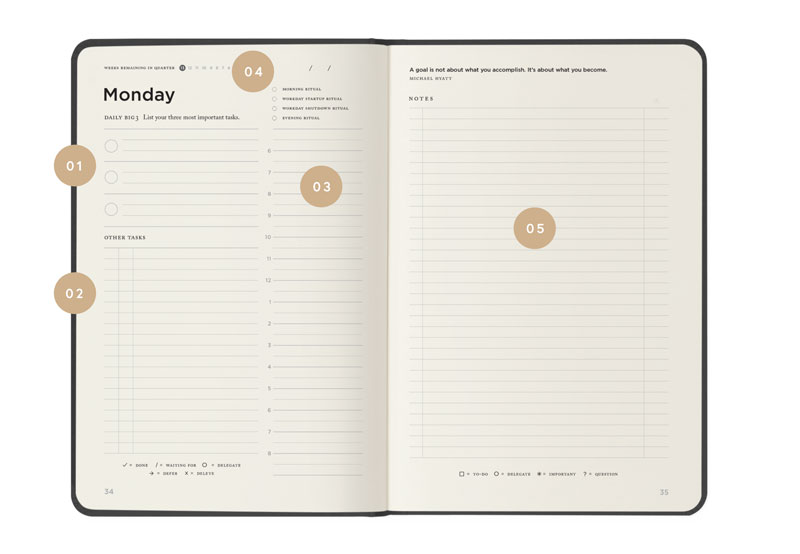One Simple, Proven Trick that Will Set You up to Win in 2017
Tell me this hasn’t happened to you: At the end of the year, you brainstorm several goals. You start the New Year full of determination and enthusiasm. But after several weeks, you get distracted and lose ground.
Months later you realize you’ve made no real progress. You either feel lousy and quit, or feel lousy and try again—only to experience the same dynamic.
But what if I told you it takes only two little words to break out of that cycle?
It’s easy to get distracted and derailed, even when we’re pursuing goals that really matter to us. The problem is that progress takes willpower, and willpower is like a muscle. Flex it a lot, and it wears out.
To make progress and achieve our goals we need to give our willpower a break without losing momentum. How?
Give Yourself a Break
I love running today, but that doesn’t mean it came easy. As much as I knew I needed to run, unless the weather outside was amazing I sometimes got stuck. I had to decide each time that running was good for me and helped me reach my fitness goals.
Seems like a small decision, right? But willpower researchers say every decision wears us down to some degree. If we make enough decisions we can drain our energy so low that we won’t make the right call, even if we know it’s a good idea.
That can kill our goals faster than anything. It’s what kills most New Year’s Resolutions after just a few weeks.
The solution is to remove the decision. Instead of choosing to run in the moment, I started laying out my running gear in advance. I didn’t have to decide—just follow the decision I had already made the night before.
Without realizing it at the time, I was creating what goal researchers call an implementation intention. In my 5 Days to Your Best Year Ever goal-setting course, I refer to it as contingency planning.
Think of it as a simple if/then statement created as a pre-response. That way, whatever obstacle we face, we’ve already decided how to get past it. Those are the magic words: if and then.
Planning to Win
This kind of contingency planning works by first creating a cue, and then “forg[ing] an association between that cue and a response that is instrumental for obtaining one’s goal,” say researchers Thomas L. Webb and Paschal Sheeran.
Let’s say your goal is to leave the office every day at 5 p.m. on the nose to be with your family. But you have phone calls, coworkers coming to talk, last-minute meetings, and more.
Every new request requires you to decide what matters more: leaving, or the urgent requests that keep coming up. It wears down you resolve, and suddenly you’re now walking out the door at 5:45.
To get past these obstacles, you could create a series of implementation intentions designed to address all the things that might keep you late. Here are just four:
- If I get a phone call after 4:45 p.m., I will let it go to voicemail.
- If a colleague sees me getting ready to leave and wants to talk, I will let them know that I’m happy to do so tomorrow but I’m expected home now.
- If I get a meeting request for 4 p.m., I will let the organizer know that I need to exit five minutes before the top of the hour and prepare my things for departure before the meeting.
- If I have email to answer before the end of the day, I will do so by 4:30 p.m. and won’t check email again after 4:45.
Whatever your goal, the trick is to simply think through the contingencies that will prevent you from achieving it. Once you’ve thought through the most likely hangups, you can pre-respond so you know what to do the second they occur.
Try Creating Your Own
Consider one goal that matters to you right now. Maybe it’s a goal you missed for 2016. What would it take to achieve it in 2017?
A good way to answer that question is to consider what got in your way this year. Now, craft a few implementation intentions to address those obstacles. Like the examples above, put these in the first person and commit to reviewing them often.
Contingency planning smooths out the friction we experience trying to maintain momentum and gives us a way to overcome obstacles. Once you’ve used them a few times, they’ll become second nature. I don’t have to remind myself to go running any longer. It’s just what I do.
It might take a little imagination to think through the potential obstacles to your goals, but it’s worth it. According to researchers Peter M. Gollwitzer and Gabriele Oettingen, in almost a hundred studies with more than 8,000 total participants, implementation intentions like these had a significant impact on helping people maintain momentum and reach their goals.
If that weren’t enough, research by Webb and Sheeran shows that implementation intentions can help us reach our goals faster.
We all know we’re going to face obstacles. But if we plan ahead, we have a better shot at overcoming them and reaching our destinations. And all it takes is two little words to get started.
If you’re interested in achieving your most important goals in the New Year, I’m hosting a free, new webinar called 7 Steps for Taking Control of 2017: How to Leverage Goal-Setting to Design the Life You Want. Don’t miss it. Registration is free but spots are limited.
What would be possible in your life if achieved your top goal for 2017?Disclosure of Material Connection: Some of the links in the post above are “affiliate links.” This means if you click on the link and purchase the item, we will receive an affiliate commission. Regardless, we only recommend products or services we use and believe will add value to our readers. We are disclosing this in accordance with the Federal Trade Commission’s 16 CFR, Part 255: “Guides Concerning the Use of Endorsements and Testimonials in Advertising.









